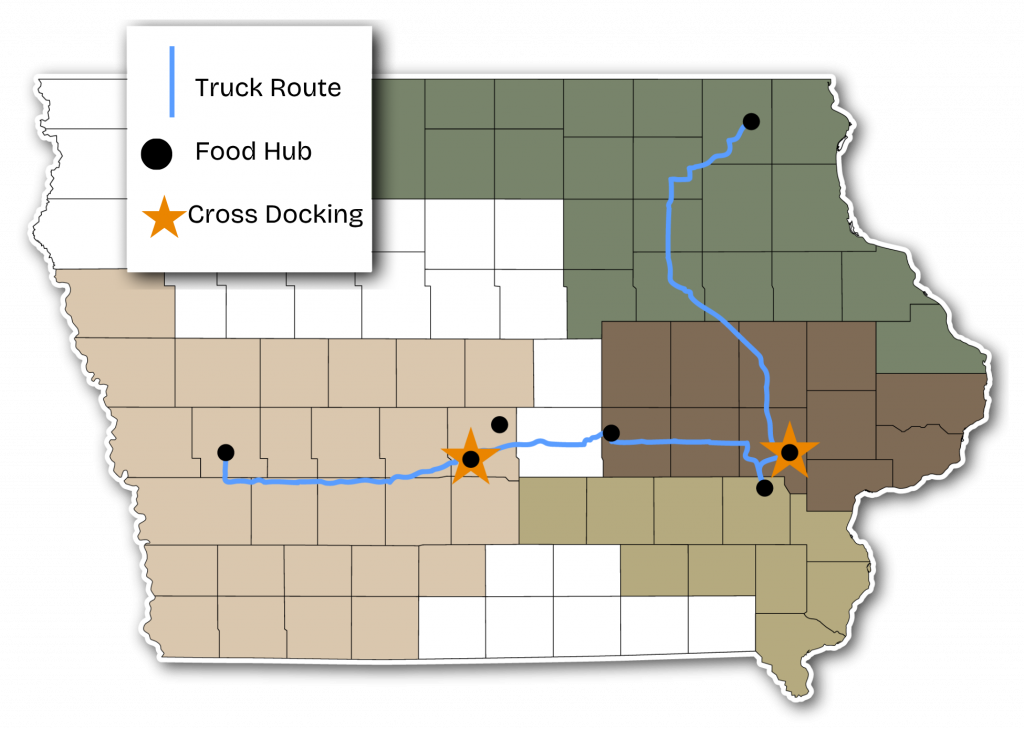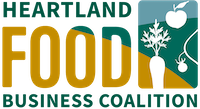Local food. Small potatoes?
Not for some 450 farmers and food business owners who moved $4.3 million worth of local products last year in Iowa.
It was a milestone year for a group of grassroots local food distributors that have linked up across the state to market and deliver small farm and food business products. A new 2024 Impact Report shows these community-based distributors, or food hubs, also delivered significant cost savings and revenue to the small farms and local food businesses they serve.
“It has been a total lifesaver for us to have these delivery services available,” said Maren Beard, co-owner of Luna Valley Farm in Decorah. Maren and husband Tom are young farmers building a business and a life on the land they love. They cater to nearby residents with pizza nights on the farm. They also market grass-fed beef and lamb to customers around Decorah and well beyond thanks to statewide, interlinked food hub distribution services.
“I already have two customers who have put down deposits on beef halves because it can be delivered close to where they live, which is over 150 miles away,” she said. “They didn’t bat an eye at the delivery charge when spread across 200 pounds of meat; it saves them a ton of travel time.”
Why Food Hubs
Food hubs are essential to overcoming the lack of distribution and related services for local farm and food businesses supplying local markets. Such essential farm-to-plate business functions in the “middle of the supply chain” are largely gone. Most food now moves globally and nationally through large processing facilities and centralized warehouses.
Yet opportunity is growing for food and farm businesses that can deliver the goods that buyers want from local food. Shelf life, for example. Local products spend less time on the road and in warehouses; local greens for chefs and local yogurt in stores last longer.
The Iowa Food Hub Managers Working Group began in 2015 organizing on the ground partners to start filling in some of the middle of the supply chain for local food and farm markets. This group formed the Iowa Hub to Hub Network with assistance from Heartland Center partner Iowa State University Extension and Outreach, Iowa Valley RC&D, and other partners.
Seven food hubs in the Iowa Hub to Hub Network now work together to provide services that reduce time and costs for producers, get more local food to more markets, and help producers keep more of the final sales dollar.
Participating food hubs are themselves small businesses. They are stepping in to connect and develop regional distribution systems that help farms distinguish their products in the market and help buyers know where their food comes from and how it was produced.
Hub to Hub Network
Time and cost savings result from hub managers identifying and connecting needed resources, such as cold storage. They also team up to coordinate efforts, from online ordering to connecting routes through cross-docking.

Services for local food producers that the food hubs serve added up last year to $90,000 in the form of transportation and logistics, refrigeration, storage space, online market access, and more.
“Without food hubs, farmers would have to arrange all of their own sales and spend a lot more time behind the windshield than they want to drive their products to far away markets, said Tommy Hexter with Iowa Farmers Union. He and others explain how the Iowa Hub to Hub Network works in this overview video.
The network’s interconnected routes extend each farms’ reach, said Hexter. “You deliver to one food hub and then those food hubs manage the coordination and distribution to move that product around the state for the farmer.”
Last year the network connected small farm and food businesses with grocery stores, households, restaurants, school districts, food access organizations and other customers in 68 of Iowa’s 99 counties.
The Iowa Hub to Hub Network also makes it easier for food hubs to offer more products together than they could individually, said farmer and food hub operator James Nisly of Camp Creek Organic Produce.
Last year, the network’s seven food hubs sold more than $330,000 of product to each other to fill supply gaps in their regions and create more robust offerings for customers.
“If one food hub has access to certain products that another food hub needs, then there’s a system of communicating and transporting those products between the different food hubs to expand what any one food hub can offer to their individual customers,” Nisley said.
Goal: Healthy Farms
Iowa is a leader in not only organizing food hubs to ramp up the volume and reach of local food in the market, but also to make sure local food producers realize real revenue from it.
Last year, the Iowa Hub to Hub Network returned 78 cents of every dollar to their suppliers, who range from livestock producers and fruit and vegetable growers to makers of cheeses, drinks, and other value-added products. In contrast, the average return to farmers in the mainstream food industry is 16 cents on the dollar.
Two big customer segments in 2024 were schools and community food providers, such as food banks. The Iowa Hub to Hub Network last year sold $1,184,556 to more than 200 school districts, colleges, and child care sites. It sold $1,001,837 to more than 120 food access organizations.
Federal funding supported some of those sales, which in turn helped the farms, food businesses, and food hubs involved in the Iowa Hub to Hub Network build their capacity to serve larger markets down the road. Innovations last year included development of a resource for publishing the prices of local products to help everyone get a gauge on going rates. Such important reference resources do not exist on the whole for local and regional food markets.
The now-canceled Local Food for Schools (LFS) and Local Food Purchasing Assistance (LFPA) programs were similar to economic development efforts common in other sectors, such as manufacturing. They provided a base level of guaranteed sales, which gave businesses confidence and buttressed food hubs’ middle-of-the-supply chain work.
More than sales, the Iowa Hub to Hub Network’s milestone year demonstrated the potential for Iowa’s local food economy to grow even more robust with continued support, said Teresa Wiemerslage, field specialist with the Farm, Food and Enterprise Development program at Iowa State University Extension and Outreach.
It showed what producers and food hub partners can do together, and with strategic investment, she said “to get this system growing and selling at scale.”
